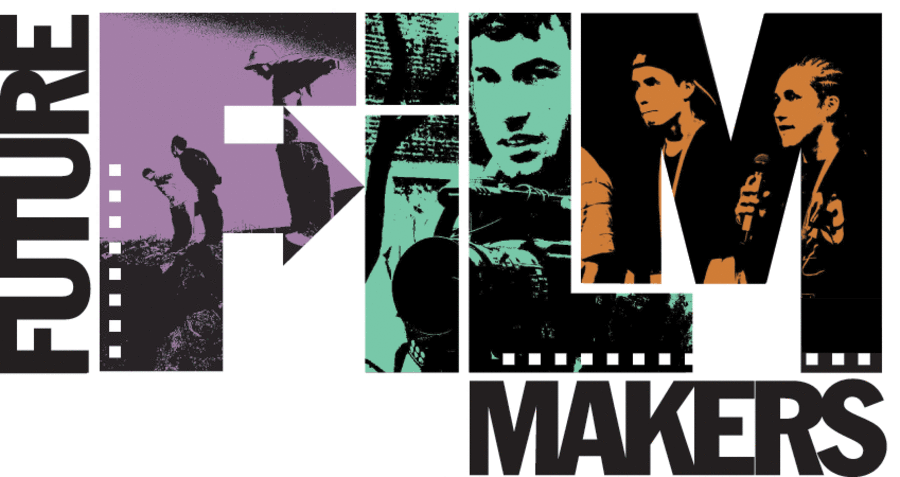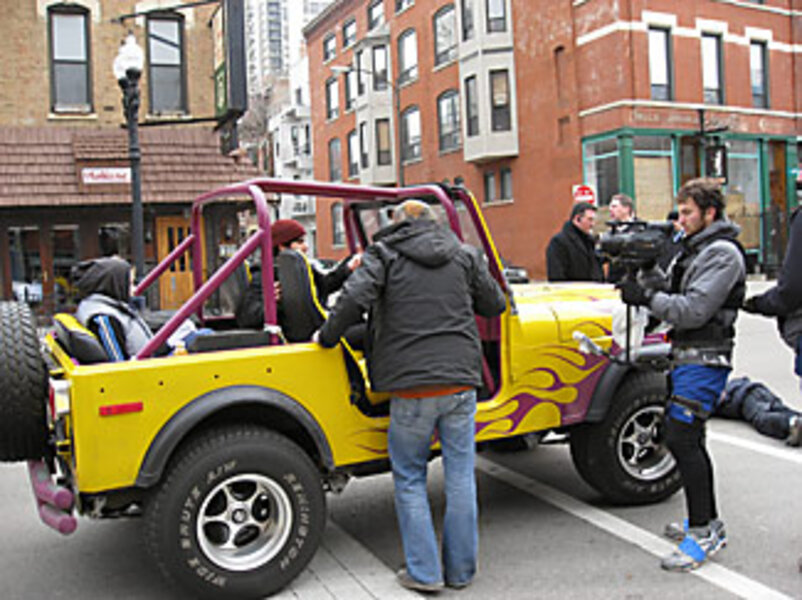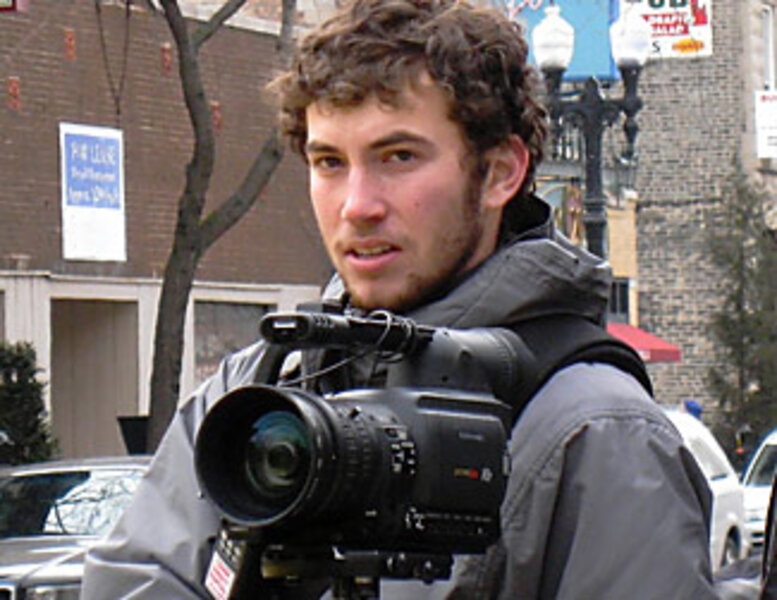In Chicago's streets, a thriller shot in a single take
Loading...
| Chicago
It's just after 6:30 on a cold Chicago Friday morning as director Aram Rappaport waits for the sunrise to hit the right point. Once the light is "dewy" he'll start filming the opening scene of the crime thriller "Helix." But the pressure is on: He won't get a second chance to get it right.
That's because this 20-year-old, first-time director is making his kidnap drama in a single take – without any editing. Once the camera starts rolling, it's nonstop action through the streets of Chicago – including a race down Lake Shore Drive and a two-mile chase sequence on foot – until the final scene 85 minutes later.
After five days of trying to film "Helix" in its entirety, the predawn crew is bracing itself. Despite having a police escort and crew members fanned out across the city, each day of filming has brought close calls – or minor disasters. On Tuesday, the cameraman blew over. "A 40-mile-an-hour gust came off the lake and literally knocked him over," says producer James Toland. "The camera flew sideways. So we had to scrap that one."
During another attempt, the film's beat-up-looking star, Alexa Vega ("Spy Kids"), was near the beach when a concerned man on his bike stopped. Fortunately the camera had momentarily panned away. "He asked, 'Are you OK? Are you OK?,' " Vega recalls. "And I whispered, 'Yeah, I'm fine. We're shooting a movie.' " Still concerned, the man hesitated. "I'm OK," she whispered again, waving him away. Reassured, he veered out of the shot just in time.
In the end, Mr. Rappaport will pick the best version of the individual shoots. "It's like putting on a play in Chicago," says Mr. Toland. "We just took the realm of the theater out into the city."
Their approach reflects a heightened interest in experimenting with filmmaking techniques and trying to generate buzz around a project, says David Tolchinsky, chairman of the radio, TV, and film department at Northwestern University in Evanston, Ill. The most striking example is "The Blair Witch Project," the low-fi horror made with hand-held cameras that became a huge hit. For more recent examples of novel approaches, Mr. Tolchinsky points to films such as "Russian Ark," shot in a single take, and "Timecode," a film that split the screen into four frames to show four concurrent story lines unfolding in real time.
Dawn's light, camera, action!
Back at the shoot, Toland sits in his car waiting for the steadicam camera to roll. He's part of a caravan that will follow the action through the city – and he's almost out of gas. He glances at the needle on his fuel gauge, which has sunk below the red line. "Oh, I've got time," he says. "I know my car."
Joggers drift past, unaware of the small band of filmmakers gathered on the beach. The sun crests over Lake Michigan and paints a wall of skyscrapers pink. "This is the magic hour. Cue the sun," Toland says. Then, a voice over the radio says: "OK, here we go. Action!"
The first scene is shot on the beach, and the actors and cameraman jump into a purple Jeep splashed with bright yellow flames. The Jeep tears off down Lake Shore Drive with the caravan trailing behind. The vehicle weaves in and out of traffic as wind whips through the actors' hair. "This is the most stressful part of the drive," Toland says. The needle on his gas gauge sinks lower.
"Helix" is loosely based on a real kidnapping of a young woman that occurred in Chicago. To Rappaport, telling the story in one take was important.
"I was really interested in that moment of desperation and why people react in a certain way. I wanted to show the event in real time ... and see how people react as time progresses," says the director. "To do justice to the story, we had to do it in a way that doesn't break the audience out of the movie."
For a homeless man, a Catch-22
While "Helix" is gritty and clearly aimed at a teenage audience, it probes moral dilemmas and issues of courage, survival, and redemption. The kidnappers have made some wrong decisions and get entangled in their mistakes. In the meantime, a homeless character is torn between getting involved and keeping silent.
"One of the themes is that people don't really do anything," says Rappaport, who studied acting and theater at California State University at Northridge and has since written, and starred in, several small independent films. Symbolic shoes
Shoes also play a symbolic role in the film. One of the kidnappers is wearing someone else's shoes. Vega's character is forced to remove her shoes to make it difficult for her to escape. The homeless man, "a symbolic truth-teller," says Rappaport, has saved his money to buy shoes so he can get into the library to read. His shoes are stolen and he tries to find them.
"We base our humanity on so many material things, and with something just as simple as losing a pair of shoes you can be sort of de-classed," Toland says. "The theme is everybody's survival. Well, what do you need? You need shoes to survive."
The Jeep exits Lake Shore Drive. Toland spots a gas station. "Sputter, sputter," he says, jokingly, as he pulls in. "Made it."
Amid all the activity, actors try to stay in character and remember their lines – without the luxury of a second take. "Every day I've messed up a line, but these guys will cover for me, and we'll keep the scene moving," Vega says.
In several scenes, actors had to improvise to fill time while waiting for a red light to change or for pedestrians to move. "There's a lot of ad-libbing," says Carlo Garcia, who plays one of the kidnappers. "Of course you don't want to say something like, 'So how 'bout them Cubs,' " he adds, laughing.
They hope the end result is a film that feels authentic. "We're really trying to tell a story as raw and as real as it possibly could be," says Vega. "I've been running around Chicago in my socks. It's not about pampering here. It's really just about making a movie for the love of it."
The biggest challenge: distribution
The next step for filmmakers is to find a distributor, but if the writing and talent aren't there, then the one-take gimmick may not work.
"What really separates the good projects from the one-trick ponies is the writing," says Tolchinsky of Northwestern. Alongside the big-budget drive to get more people into theaters is a low-budget, grass-roots phenomenon spurred by the lower cost of moviemaking technology and a YouTube generation that feels empowered to take charge of the camera. This has led to a "democratization" of filmmaking, he says.
"It's easier to get things done," says Tolchinsky. "There's lots of outlets on the Web, and there's editing systems that most people can afford."
Not that these filmmakers will be needing an editor – which will save time and money – though Rappaport is allowing for color correction and sound editing.
Today's take included more improvisation than the others. The actors jumped on a city bus and ran through a convenience store, but there were technical problems with the microphones, and a crew member wound up in a shot. It looks like this day will be scrapped, says Rappaport.
But when asked how other shoots have gone, he replies, "I think Wednesday was a great take. That's the day," he says smiling.







